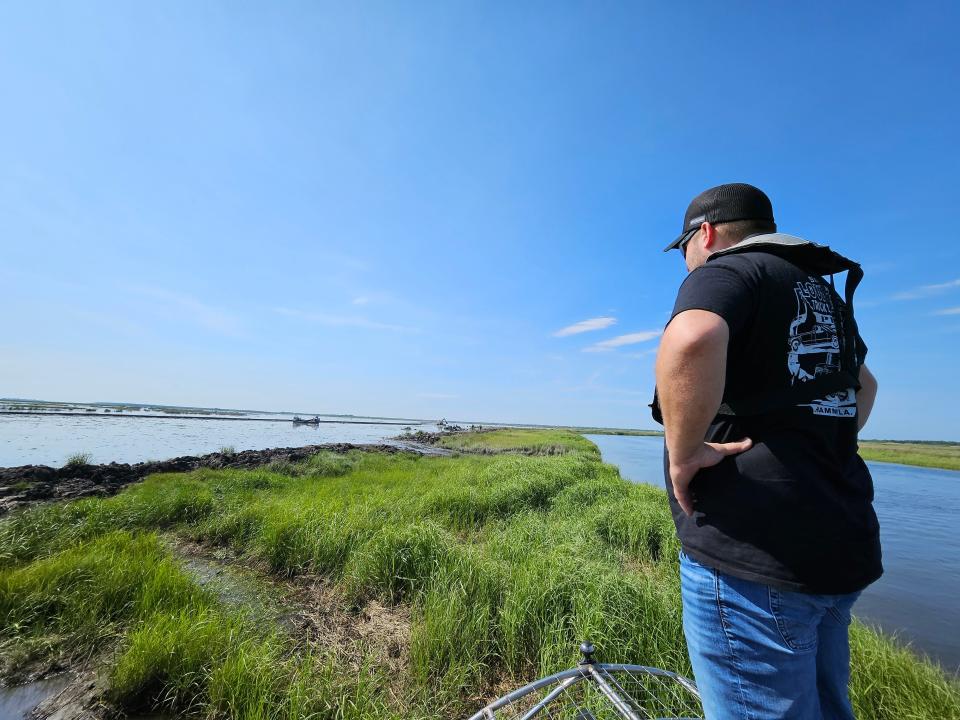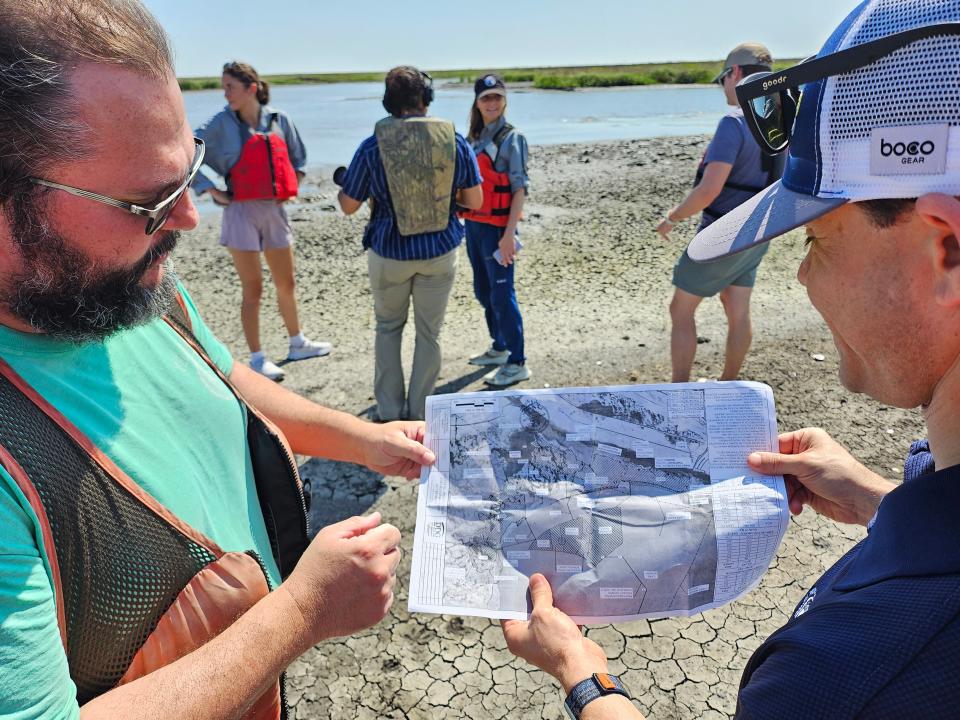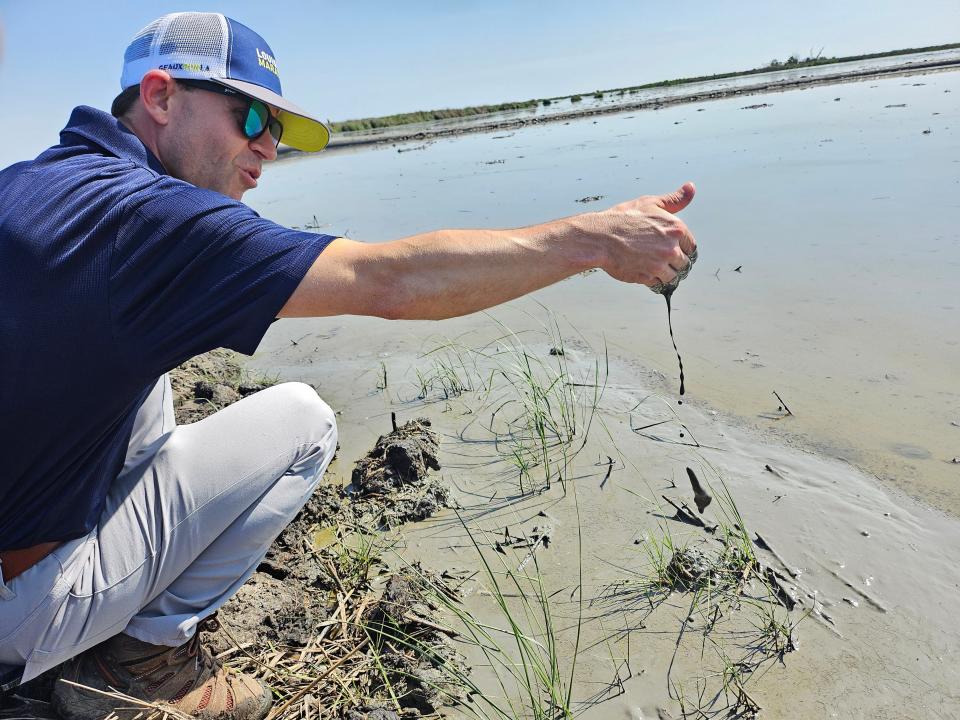Louisiana's largest marsh restoration project nears completion, plans to bring them here
The largest marsh restoration project in Louisiana's history is rebuilding nearly three-thousand acres of marsh in a St. Bernard Parish lake. Plans are on the books to bring the process to Terrebonne and Lafourche.
The $114.7 million project spans six-and-a-half miles in length and a-mile-and-a-half in width of Lake Borgne. It's located about 10 miles east of New Orleans and encompasses 2,769 acres of marsh. The project was awarded to Duplantis Design Group in 2016 who divided the area up into eight parts known as cells, and began construction in 2021. The Coastal Protection and Restoration Authority is in charge of the project and Executive Director Glenn Ledet Jr. showed reporters one cell that is complete and one that is in the process, May 16. The project is coming along nicely, he said, and it's looking like it may be completed under budget by the end of 2025.
"The other day we were sitting here and four red fish swam through here," Lead Designer of the project Joe Guillory said to Ledet while standing on newly created land. He was pointing to a small channel that allowed water to flow into the area. "We were like 'nailed it!'"

The crew took two airboats containing reporters, a geologist, and CPRA members to the cells. Josh Guerra, a 35-year-old from Hopedale, St. Bernard, was one of the drivers. He lives about 10 minutes from the dock and grew up fishing in the lake. The area had changed so much he had to pull up a map to refresh his memory. His old hunting map hadn't been updated and it still showed his position as areas of open water where now lush green marsh grass waved in the wind.
He noticed the marsh vegetation recede after Hurricane Katrina blew through. As he tells it, there used to be small openings in the marsh grass, like tiny ponds, but over time those ponds grew in size. The vegetation vanished, and the ponds got deeper until only open water remained. Coming out to see the project, Guerra said, it was beginning to look like it did when he was a child again.
"They always had a nice ridge there," he said pointing from the airboat. "You can kinda see where the trees once were."

Michael Hopkins, a Geologist with the nonprofit Pontchartrain Conservancy, said as the marsh recedes it opens further land up to be smashed by the next hurricane. This creates a snowball effect, allowing storm surges to grow in size and further destroy habitat for people and wildlife. Rebuilding the marsh is vital for wildlife and hurricane protection, he said.
The marsh acts as a buffer between hurricanes' storm surge effect, truncating the initial wave and cutting down its force. This has a twofold effect: both reducing the damage of the surge, and cutting down on the distance it throws saltwater on land. That saltwater would otherwise further kill vegetation and open the land up to more erosion by killing the plants the root the land in place.
The marsh restoration project encircles one of the many cells with mud levees, around 850 acres for cell MCA2. Then sediment is pumped in from the bottom of Lake Borgne. This is done with what looks like a giant kitchen mixer that stirs the bottom of the lake, and then the mud is sucked into a pipe and spewed into the center of the bowl. From there, workers in excavators push the slurry around to ensure an even layer is distributed across the bowl.
When it's finished it should be about 3.5 vertical feet above sea level, and over the next decade it should settle to about 1.2 feet. Engineers are ensuring that the height matches the surrounding area to promote healthy marsh growth. In total, 13 million cubic yards of sediment will be pumped from the bottom of Lake Borgne and deposited in the eight cells to rebuild marsh. For perspective, that much sediment could fill the Superdome three times.

To show off healthy marsh growth, Ledet brought the group to a cell that was complete, MCA4. Vegetation was regrowing and the wildlife was in action. The water constantly rippled with minnows as marsh hens tried and often succeeded at catching the tiny meals.
Hopkins said one could hear the success of the project.
"It looks great! I mean it's vegetating. It's, listen," he motioned his hand up and got quiet. Birds and bugs could be heard chirping, buzzing, and the water splashing. "It's alive."
Terrebonne and Lafourche have many similar projects on their way, some beginning as soon as 2026. The projects include areas between Chauvin and Golden Meadow, and another between Port Fourchon and Golden Meadow. One of the projects titled the Bayou Terrebonne Ridge Restoration is a $165 million project. The funds are in place, and the planning is complete for a 400 acre project. CPRA is currently in the process of acquiring the land to carry out the project.
This article originally appeared on The Courier: Louisiana's largest marsh restoration project nears completion

